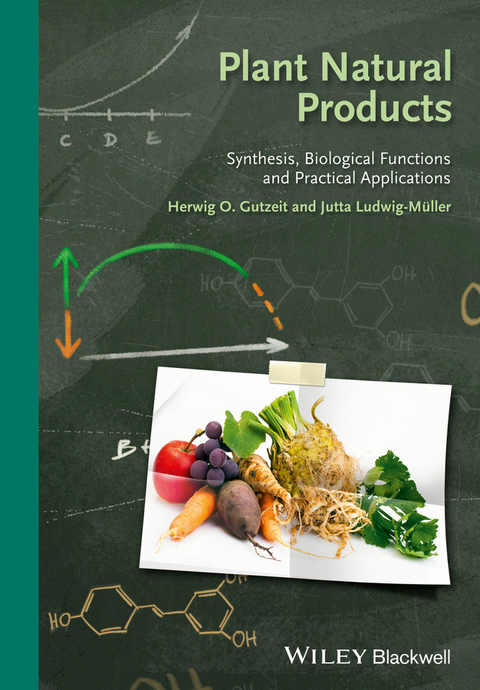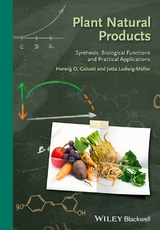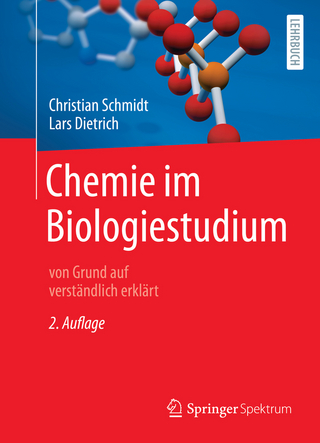Plant Natural Products
Wiley-VCH (Verlag)
978-3-527-68198-3 (ISBN)
Herwig Gutzeit is Director of the Institute of Zoology at the Technische Universität Dresden, Germany. After graduating from Oxford University (Rhodes Scholar) he obtained his PhD from Basel University (Switzerland). He habilitated at Freiburg University, Germany, and became a member of the Founding Committee of the Department of Biology at the TU Dresden where he works as Professor for Zoology and Developmental Biology since. Prof. Gutzeit published numerous scientific papers in the field of Developmental Biology and he studied the interactions of natural substances with molecular targets in animal and human cells. Jutta Ludwig-Müller is Professor for Plant Physiology and Director of the Institute of Botany at the Technische Universität Dresden. She received her Diploma and Doctoral degree from Goethe-Universität, Frankfurt, Germany, where she also got her Habilitation in botany. She spent some time in the USA as research associate at Case Western Reserve University, Cleveland, and as guest scientist at the United States Department of Agriculture, Beltsville. Prof. Ludwig-Müller has published over 100 scientific papers. She is also Editor-in-Chief of the Journal of Plant Growth Regulation. Among other topics she studies the various roles of secondary metabolites in plants.
Preface XI
1 Biosynthesis and Chemical Properties of Natural Substances in Plants 1
1.1 Selected Classes of Secondary Metabolites 3
1.1.1 Occurrence and Compartmentation 3
1.1.2 Biosynthesis 11
1.1.2.1 Alkaloids 12
1.1.2.2 Phenol Derivatives, Especially Flavonoids 19
1.1.2.3 Betalains 22
1.1.2.4 Cyanogenic Glycosides, Glucosinolates, and other Indole Derivatives 24
1.1.2.5 Terpenes 29
1.1.3 Transcriptional Control 31
1.1.4 Transport of Secondary Metabolites 39
1.2 Evolution of Natural Compounds in Plants 44
1.2.1 Parallel Evolution of Similar Pathways 46
1.2.2 Gene Duplication 48
1.2.3 Gene Clusters 52
1.2.4 Natural Variation 58
1.2.5 Modulation of Different Molecules with Similar Functions 59
1.2.6 Evolution by Stress Factors 60
1.2.6.1 Abiotic Stress 60
1.2.6.2 Biotic Factors 61
1.3 Biotechnological Applications 62
1.3.1 Identification and Quantification of Natural Plant Products 62
1.3.2 Biological Activity 67
1.3.3 Biotechnological Production of Natural Compounds 68
2 Function of Natural Substances in Plants 81
2.1 Secondary Compounds in Primary Metabolism 81
2.2 Development 83
2.2.1 Vegetative Growth 85
2.2.1.1 Structural Polymers 87
2.2.1.2 Flavonoids and Auxin Transport 88
2.2.1.3 Glucosinolates and the Biosynthesis of IAA 90
2.2.1.4 Polar Growth 91
2.2.1.5 Cytoskeleton and Cell Cycle 91
2.2.1.6 Alkaloids and Growth 93
2.2.1.7 Senescence 95
2.2.2 Reproduction: Male Fertility 95
2.2.3 Flower Biology: Pollination 98
2.2.3.1 Nutrients 98
2.2.3.2 Aroma Volatiles 99
2.2.3.3 Color 105
2.2.4 Fruit and Seeds 109
2.2.4.1 Fruit Development 109
2.2.4.2 Seed Formation 112
2.2.4.3 Seed Dispersal 112
2.2.4.4 Seed Dormancy 113
2.3 Abiotic Stress 115
2.3.1 Antioxidative Properties in Plants 116
2.3.2 Light and UV Irradiation 118
2.3.3 High Temperatures 120
2.3.4 Cold, Salt, and Drought Stress 122
2.3.5 Nutrient Deficiency 122
2.3.6 Environmental Pollution 123
2.3.6.1 Heavy Metal Stress 123
2.3.6.2 Air Pollution 124
2.4 Symbioses 124
2.4.1 Rhizobia 125
2.4.2 Mycorrhiza 127
2.4.3 Endophytic Fungi 131
2.4.4 Lichens 131
2.5 Defense 132
2.5.1 Pathogens 134
2.5.1.1 Preformed Defense Response 136
2.5.1.2 Induced-Defense Response 143
2.5.1.3 Systemic Acquired Resistance 153
2.5.2 Antimicrobial Potential in Plant Protection (Biofumigation) 154
2.5.3 Invertebrate Herbivores 154
2.5.3.1 Insects 155
2.5.3.2 Phytopathogenic Fungi Alter the Chemical Defense of Plants Against Insects 163
2.5.3.3 Biological Plant Protection Against Insects with Secondary Metabolites 164
2.5.3.4 Nematodes 164
2.5.3.5 Snails/Slugs 166
2.5.4 Parasitic Plants 166
2.6 Allelopathy 170
3 Biological Effects on Microorganisms and Animals 175
3.1 Coevolution 175
3.1.1 Adaptation Mechanisms of Microbes and Herbivores 179
3.1.1.1 Fungi 182
3.1.1.2 Insects 182
3.1.1.3 Vertebrates 187
3.1.2 Attraction of Insects 189
3.2 Effects on Vertebrates: An Overview 198
3.2.1 Structural and Functional Diversity of Natural Substances: Challenges and Promises 198
3.2.2 Molecular Interactions with Cellular Components 201
3.2.2.1 Protein Targets 201
3.2.2.2 Interaction with Nucleic Acids 206
3.2.2.3 Interaction with Lipids 206
3.2.2.4 Interaction with Carbohydrates 206
3.2.2.5 Metal Chelators 207
3.2.3 Visualization of Natural Substances in Living Cells 209
4 Metabolism and Toxicity of Natural Substances in Mammals 213
4.1 Metabolism of Natural Substances in Mammals 213
4.1.1 Principles of Pharmacokinetics 213
4.1.1.1 Absorption, Distribution, Metabolism, and Excretion 216
4.1.2 Case Studies of Selected Natural Compounds 221
4.1.2.1 Quercetin 221
4.1.2.2 Catechins and Proanthocyanidins 224
4.1.2.3 Resveratrol 224
4.1.2.4 Morphine 226
4.1.2.5 Nicotine 227
4.1.3 Metabolic Bioactivation 229
4.1.4 Effects
| Erscheint lt. Verlag | 2.4.2014 |
|---|---|
| Verlagsort | Weinheim |
| Sprache | englisch |
| Maße | 170 x 244 mm |
| Gewicht | 970 g |
| Themenwelt | Medizin / Pharmazie ► Medizinische Fachgebiete |
| Naturwissenschaften ► Biologie ► Biochemie | |
| Naturwissenschaften ► Biologie ► Botanik | |
| Naturwissenschaften ► Chemie | |
| Schlagworte | Biopharmaceuticals & Pharmaceutical Biotechnology • Biopharmaceuticals & Pharmaceutical Biotechnology • Biopharmazeutika u. Pharmazeutische Biotechnologie • Biopharmazie • Biowissenschaften • Botanik / Physiologie • Chemie • Chemistry • Life Sciences • Medical Science • Medizin • Pflanzenphysiologie • Pharmacology & Pharmaceutical Medicine • Pharmacology & Pharmaceutical Medicine • Pharmakologie u. Pharmazeutische Medizin • Plant Physiology |
| ISBN-10 | 3-527-68198-1 / 3527681981 |
| ISBN-13 | 978-3-527-68198-3 / 9783527681983 |
| Zustand | Neuware |
| Haben Sie eine Frage zum Produkt? |
aus dem Bereich




